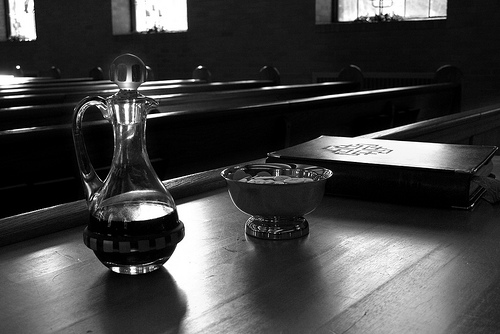Lectionary Reflection
Third Sunday of Easter, May 8, 2011
But we had hoped that he was the one to redeem Israel. Luke 24:21
How often have you heard the words “we had hoped” used in church circles? They are usually accompanied by a sigh and language such as “We had hoped that giving would be better this year.” “We had hoped to have some new members.” “We had hoped our youth program would take off.” “We had hoped to start a contemporary service.”
Unfortunately, the verbiage “we had hoped” is most often accompanied by the coordinating conjunction “but” followed by an explanation, rationalization, or theory about why what was hoped for did not come to pass. “We had hoped that giving would be better this year, but with the economy, you know.” “We had hoped to have some new members, but nobody came back after the first visit.” “We had hoped our youth program would take off, but we’re just too small to have critical mass.” “We had hoped to start a contemporary worship service, but we don’t have the musicians to do it.”
 If similar sad tales emit from the mouths of the good church folk you know, rest assured that you are dealing with a case of “Past Tense Hope” Syndrome. You’ll find it manifests itself in symptoms such as hang dog looks, defeatist attitudes, and flagging interest. It is an all too common malady among mainline churches today. People with this syndrome also tend to experience a lack of vision and clear sight. Sometimes they can’t see the answer right in front of their noses. The good news is that while this syndrome is serious, it does not have to be fatal if treated quickly and properly.
If similar sad tales emit from the mouths of the good church folk you know, rest assured that you are dealing with a case of “Past Tense Hope” Syndrome. You’ll find it manifests itself in symptoms such as hang dog looks, defeatist attitudes, and flagging interest. It is an all too common malady among mainline churches today. People with this syndrome also tend to experience a lack of vision and clear sight. Sometimes they can’t see the answer right in front of their noses. The good news is that while this syndrome is serious, it does not have to be fatal if treated quickly and properly.
The gospel reading for this week contains a prime example of “Past Tense Hope” Syndrome. Cleopas and his friend entered Jerusalem full of dreams and high hopes; now they are headed to Emmaus with heavy hearts and muddied vision. In fact, their vision is so unclear and their focus so cloudy that they fail to recognize Jesus is right there with them. It is only when they see him in the most obvious of acts–breaking of bread–that they realize through past-tense hindsight what has just happened. The good news is that Jesus’ making himself known to them in this act enables them to find new hope and enthusiasm. Realizing their hearts have been afire all along, they head back to Jerusalem to share their good news.
 How should one treat a case of “Past Tense Hope” Syndrome today? Begin with the obvious: Word and Sacrament. Encourage those manifesting signs and symptoms of this malady to come into frequent contact with God’s word and Christ’s meal. Then, like Jesus did with Cleopas and his pal, unpack scripture by retelling and explaining the great faith narrative. Once a person begins to see him or herself as woven into the fabric of God’s people, a sense of vision and a glimmer of hope should break through the darkness. Finally, provide the syndrome sufferer with an opportunity for “present tense action.”
How should one treat a case of “Past Tense Hope” Syndrome today? Begin with the obvious: Word and Sacrament. Encourage those manifesting signs and symptoms of this malady to come into frequent contact with God’s word and Christ’s meal. Then, like Jesus did with Cleopas and his pal, unpack scripture by retelling and explaining the great faith narrative. Once a person begins to see him or herself as woven into the fabric of God’s people, a sense of vision and a glimmer of hope should break through the darkness. Finally, provide the syndrome sufferer with an opportunity for “present tense action.”
There is no better cure for “Past Tense Hope” Syndrome than opening one’s eyes to catch a glimpse of the holy in everyday life. Once that happens, it is much easier to get back to discipleship by transferring that “Past Tense Hope” into “Future Tense Vision” through “present-tense action.” You see, Jesus is still right there with us. We are not orphaned and left to despair. We always have hope–even when we fail to see it.
Hey, was not your heart burning within you as you thought about how God just might be at work in your context turning those “past tense hopes” into reality? If so, I bet you are out of danger when it comes to “Past-Tense Hope” Syndrome. I pray you see the risen Christ in all you do and in everyone you see. Blessings on your preaching and teaching this week!
Visual
Here’s a meditation on the song “In the Breaking of the Bread” sung by Kitty Cleveland and posted on YouTube.
With Youth
Share Lost & Found’s 1995 song “Hearts” with your youth group. A YouTube version is available here. Talk about what it means to have “hearts on fire” for the gospel. What did Cleopas and his friend mean when they asked each other “Were not our hearts burning within us while he was talking to us on the road, while he was opening the scriptures to us?”
With Children
Take children on a walk around your church building and ask them where they see Jesus. If you do this during a children’s sermon time, simply walk around or look around the sanctuary. The children may point to pictures, crucifixes, etc. Point out the elements of the Eucharist as a place where we meet Jesus. Make sure to note that we see the face of Christ in one another.
Photos by Andy Coan, Steve Snodgrass, and khrawlings used under Creative Commons License. Thanks!




Great sermon. But one variable to consider is where Jesus went in the discussion with them – into the past – but further in the past to be sure. I think he meets us where we to help us see the holy in everyday life (as you put it well). Thanks Sharron. Tom
Hi, Tom.
Good point about where Jesus leads the discussion! Past, present, future–you are right; Jesus meets us where we need to be met, even when we can’t see our Lord right in front of our faces. Thanks be to God. Blessings on your preaching! Sharron
You know, for me it was the fact that church is so incredibly boring that was the last straw. The songs are boring, the ceremony looks stupid, the clothes look ridiculous…..
Eventually I just said to myself: “Why am I wasting my time on this stupidity?”
Hi, NixonisLord. Sorry your experience with “church” has been such a disappointing one. Not all faith communities are boring and meaningless. I hope you’ll give it another chance at some point and will find a community of believers with whom you resonate and have–as this coming week’s text from John 10 (vs. 10) says–life, and have it abundantly.